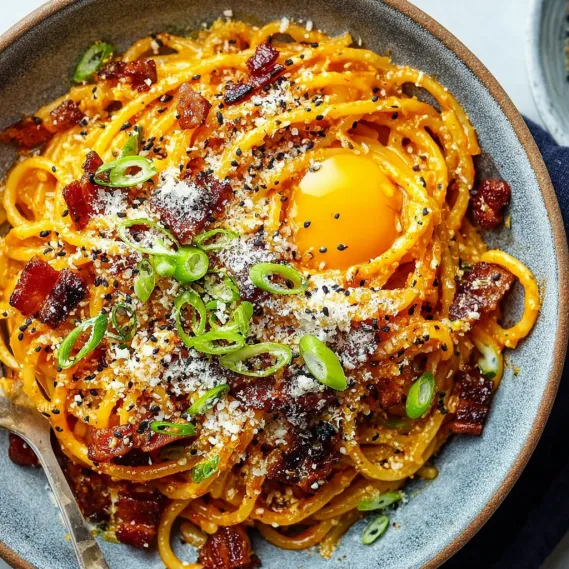 Pin
Pin
This hearty gochujang carbonara takes the classic Italian pasta dish to new heights with a spicy Korean twist. The combination creates a luxurious, creamy pasta with just the right amount of heat that will leave you craving more after the first bite.
I first made this fusion dish when looking for ways to use my newly purchased tub of gochujang, and it immediately became my go-to impressive dinner party recipe. The reactions from guests are always priceless when they taste this unexpected combination.
Ingredients
- Thick-cut bacon: Creates the rich, savory base for the sauce and adds delicious texture
- Pecorino romano or parmesan cheese: Provides the salty, umami foundation traditional to carbonara
- Large eggs at room temperature: Forms the silky, creamy sauce that coats each strand of pasta
- Gochujang: The star ingredient that adds complex sweet, savory and spicy notes
- Kosher salt: Enhances all the flavors in the dish
- Garlic powder: Adds depth without overwhelming the other flavors
- Black pepper: A carbonara essential that balances the richness
- Pasta: Choose thicker shapes like fettuccine or shellbows to hold the sauce well
- Scallions: Fresh, bright garnish that complements the rich sauce
- Sesame seeds: Adds subtle nuttiness and beautiful visual appeal
- Lemon zest: Optional but recommended for brightness that cuts through the richness
Step-by-Step Instructions
- Cook the Bacon:
- Heat your skillet to medium or medium-low to prevent smoking. Cook the thick-cut bacon slices on both sides until they reach a golden brown color. This slow cooking process renders the fat properly and ensures crispy but not burnt bacon. Once cooked, transfer to a cutting board, blot excess grease, and chop coarsely.
- Oven Bacon Alternative:
- For hands-off bacon preparation, place bacon strips in a single layer on a parchment-lined baking sheet. Put the sheet in a COLD oven, then set to 425°F and bake for 15-25 minutes until your desired crispiness is achieved. This method produces evenly cooked bacon with minimal splatter.
- Prepare the Sauce:
- While the bacon cooks, whisk together the grated cheese, room temperature eggs, gochujang, salt, garlic powder, and a generous amount of freshly ground black pepper in a medium bowl. The mixture should be well combined but will still be quite thick at this stage. The magic happens when it meets the hot pasta.
- Cook the Pasta:
- Bring a large pot of heavily salted water to a rolling boil. Add your pasta of choice and cook until al dente according to package directions. Before draining, reserve a full cup of the starchy pasta water. This liquid gold is crucial for creating the silky sauce consistency.
- Create the Creamy Sauce:
- After draining, immediately return the hot pasta to the pot and quickly add the egg mixture. Using tongs, toss vigorously to coat every strand with the sauce. The residual heat from the pasta cooks the eggs gently, creating a smooth, creamy coating rather than scrambled eggs. If the mixture seems too thick, stream in the reserved pasta water while continuing to toss until you achieve a glossy, luxurious sauce.
- Serve and Garnish:
- Divide the finished pasta between plates and top with the chopped bacon. Sprinkle each serving with additional grated cheese, sliced scallions, and a pinch of sesame seeds. For an extra dimension of flavor, add a light dusting of lemon zest to brighten the rich dish.

The gochujang is truly the magical ingredient in this fusion dish. I discovered its versatility during pandemic cooking experiments and have never looked back. My Korean friend who first introduced me to gochujang smiled knowingly when I shared this recipe with her, saying fusion at its finest is when ingredients find their perfect partners across culinary traditions.
Storing Leftovers
Carbonara is best enjoyed immediately after cooking, but leftovers can be stored in an airtight container in the refrigerator for up to 2 days. When reheating, add a splash of water or milk and warm gently over low heat, stirring frequently to prevent the sauce from separating. The texture will never be quite as silky as fresh, but the flavors will still be delicious.
Perfect Pairings
This rich pasta dish pairs beautifully with a simple side salad dressed with rice vinegar and sesame oil to echo the Asian flavors. For wine, a crisp Sauvignon Blanc or light Pinot Noir complements the creaminess without overwhelming the subtle heat. If you prefer beer, a Korean lager or wheat beer makes an excellent companion to balance the richness.
Gochujang Guide
If you are new to gochujang, this fermented Korean chili paste is a wonderful pantry staple that lasts for months in the refrigerator. Look for it in Asian grocery stores or the international aisle of well-stocked supermarkets. The traditional rectangular red tubs offer the most authentic flavor, but squeeze bottles are also available for convenience. Check the ingredient list if you need a gluten-free version, as some brands contain wheat.
Common Questions About This Recipe
- → How spicy is the gochujang carbonara?
The dish has a pleasant kick from gochujang, but the heat is balanced with creaminess. You can adjust the amount for your preferred level of spice.
- → Can I make this gluten free?
Yes, simply use your favorite gluten-free pasta and ensure your gochujang is certified gluten free.
- → Is bacon necessary or can I substitute it?
Bacon adds smokiness, but you can use turkey bacon or even sautéed mushrooms for a vegetarian twist.
- → What pasta shapes work best for this dish?
Fettuccine, conchiglie, or shellbows hold the sauce well, but use any shape you enjoy.
- → How do I prevent the sauce from curdling?
Combine the egg mixture with hot drained pasta off the heat, tossing quickly so the residual heat forms a silky sauce.
- → Can I make it ahead?
It's best fresh, but you can prep ingredients in advance and toss together when ready to serve.
